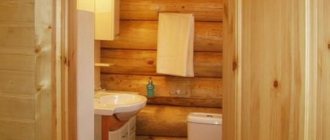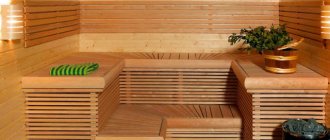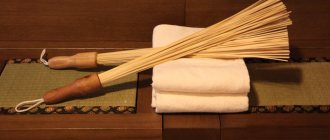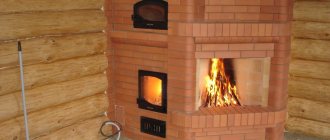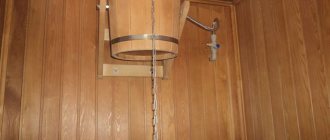The presence of water in the bathhouse is mandatory: while in the steam room, people sweat a lot, so after such a healthy relaxation you definitely need to wash. Of course, you can draw water every time, but it is much more convenient to make water supply in the bathhouse. With it, bathing procedures will become more pleasant and simple, and the absence of the need to draw water will save you from unnecessary hassle.
The presence of equipped water supply in the bathhouse certainly increases the level of relaxation comfort, makes it more enjoyable and greatly facilitates the process of preparing the steam room.
The water supply allows you to save space, because in its absence you will have to allocate space for a container for storing water. Another advantage is that the water from the tap is of better quality than that which settles in a container, since during storage various microorganisms that are harmful to humans can develop in the liquid. Clean water flows through the water supply system, passing through special filters.
Pumping water for a bath from a well
Water supply for a bathhouse from a well is the simplest and most affordable option. The daily need for water guarantees its availability in every suburban area. The water supply scheme for a bathhouse from a well is as follows:
- A submersible pump is lowered into the shaft, to which a pipeline or an ordinary garden hose is connected. Through it, water is pumped into the bathhouse.
- Instead of a submersible pump, a pump can be used, which is located next to the well or in the technical underground of the bathhouse. This method is permissible only in the case of a slight difference in height.
- The pipeline can be laid on the ground or in a trench. If there is a need for water in the bathhouse in winter, then the pipeline must be placed below the soil freezing level. All components of the water supply system, which for one reason or another are not located in the ground, must be insulated.
When making a water supply system for a bathhouse with your own hands, you need to take into account that it must have a slope towards the well. Thanks to this, the water remaining in the pipes will flow back on its own, which will eliminate the possibility of it freezing.
What pipes to use for water supply from a well
When organizing water supply for a cottage or bathhouse, it is important to choose the right pipes. They should be:
- Safe, especially if you use the water for drinking.
- Durable, since most of the pipeline is laid below the soil freezing level, replacement entails a large amount of work.
- They tolerated temperature changes well.
- Easy to install and repair.
Previously, only metal pipes were used. There were no other options. But, firstly, they rust quickly, and secondly, installation and replacement are only possible with a welding machine. Today there are other options.
Between the well and the house, cottage, bathhouse, pipes made of polypropylene or polyethylene are laid
Polypropylene pipes for water supply
In order for the water supply to serve for a long time and properly, the best option for a summer house and bathhouse is polypropylene pipes. They feel great at low temperatures; when connecting them, rubber or other gaskets are not used, which over time lose their elasticity and require replacement. They do not emit any harmful substances, do not rot or oxidize, are not damaged by fungi and microorganisms, and manufacturers claim a service life of about 50 years.
But. Polypropylene pipes require special equipment for welding. A special soldering iron is used to heat the pipe. When heated, it is quickly connected to an angle, tee, tap, etc. Important: do not make any rotational movements when welding. This is especially true for reinforced pipes. After connecting, give it a couple of minutes to cool and you can continue assembling the water supply further. The device is not very expensive, and you don’t have to buy it. You can rent a soldering iron for polypropylene from almost any company that sells polypropylene pipes.
Another good thing about polypropylene pipes is that they are available for both cold and hot water. That is, the internal wiring of the water comb in the room can also be made from the same material. Another plus: a flat and smooth outer surface, which is easy to care for and does not require painting.
Polyethylene
To supply cold water (it cannot be used for hot water), HDPE pipes are often used - low-pressure polyethylene. They have practically the same characteristics as polypropylene (they are not afraid of frost, do not rot and are not susceptible to fungi, but at the same time they are environmentally friendly), but they have one big advantage: they can not only be welded, but also use detachable fittings. This is much more convenient, does not require special equipment, and repair/replacement becomes easier. Watch the video to see how to connect HDPE pipes.
But, on the other hand, detachable fittings mean there is a high probability of leaks. Therefore, they try to plan the pipeline so that all collapsible fittings are in accessible places and not underground.
Insulation and pressure compensation
When laying pipes (polyethylene or polypropylene - it doesn’t matter), it is advisable to take measures to compensate for soil pressure. If your soils are heaving, this is a must. You need to lay the pipe (preferably with insulation, but possible without) in a corrugated hose of larger diameter. It will, firstly, serve as thermal insulation, and secondly, protect against excess pressure.
There is also Energoflex tubular insulation, using which you can solve the issue of thermal insulation in one fell swoop and protect pipes from excessive loads.
Insulation for water supply pipes "Energoflex"
Recommendation based on personal experience: buy pipes and all corner tees and taps in one place, preferably located near the house/bathhouse. Why? Because even professionals rarely manage to perfectly calculate the entire circuit at once, so during the installation process you will have to buy, change, return something more than once, and sometimes more than twice. Therefore, immediately upon purchase, find out how and what you can/will need to do to exchange and return parts of the plumbing system.
Supplying water to the bathhouse from a well
The water supply system for a bathhouse from a well is no fundamentally different from the water supply system described above. The only difference is that the well is much more difficult to develop, maintain and operate.
The task of installing a water supply system in a bathhouse will be greatly simplified if the site already has connections to a water source, for example, for pumping it into the house. In such a situation, you will have to join the existing pipeline.
It would not be superfluous to make an additional starting system for the pump so that it can be turned on from the bathhouse.
What is it and what is it for?
So what is a water bath and what are its benefits? This is a fairly simple but effective way to heat food at a controlled temperature. This method helps prevent the contents from burning or boiling.
The principle of operation is to transfer heat from one object to another through an “intermediary”, which is ordinary water.
The design consists of two containers of different diameters, into one of which water is poured. The other is installed on top so that its bottom touches the water.
The advantages of the “bath” include:
- food is heated slowly and evenly;
- substances are not subjected to severe heat treatment and do not lose their beneficial properties;
- Burning of the product is avoided.
Water cannot heat above 100°C. Accordingly, the bottom of the upper container, in which the main cooking process takes place, also cannot warm up above this value. This means that nothing can burn or burn. This method is often used in the pasteurization of products - for example, home pasteurization of jars of pickles.
Pumping station
How to bring water to the bathhouse? Where is it better to take water from: a well or a borehole? For the most part, the last question is unimportant. Both options are not completely comfortable. An ideal solution to the existing problem would be to install a full-fledged pumping station.
This is a labor-intensive process that will take a lot of effort and time, but there will always be water in the bathhouse, house and other buildings located on the plot. The operating principle of the pumping station is simple:
- Water is pumped from a well or well into a special container, the volume of which is calculated based on individual needs. As a rule, a tank with a capacity of 300–500 liters is sufficient.
- Next, the water flows to the place where the tap was opened. The redistribution of water is the responsibility of wiring, the installation of which is carried out at the discretion of the owner of the house.
- When the water level in the tank drops to a critical level, the pump is activated, replenishing the loss.
The water tank and pump must be installed in a room where the temperature does not drop to sub-zero values. The tank must be installed so that its lower part is higher than any of the taps in the system. The ideal solution could be the attic of a house or bathhouse.
The pump can be installed under the floor or in any other place. If possible, it is better to make a separate room for the pump so that the noise it makes during operation does not get on your nerves.
How to melt honey in a water bath?
Honey has excellent anti-aging properties, so it is often included in anti-aging homemade masks.
But honey tends to become sugary and hard. You cannot apply solid honey to your skin or hair; it must be heated - then it will become liquid again.
Liquefying honey
To heat honey in a water bath, heat a large pan of water to a boil, then reduce the heat to low. Then put a small saucepan with honey in a large one with water. Stirring constantly, melt the honey in a water bath; as soon as the honey becomes liquid, immediately remove the saucepan with honey from the water bath.
Do not heat honey above +50-60°C. When heated at higher temperatures, honey loses all its beneficial properties.
Differences between winter and summer water supply
In order for there to be enough water in the bathhouse and the plumbing to work properly, its installation must be carried out taking into account climatic conditions. If the bathhouse is located on a summer cottage and is used exclusively in the summer, then it is enough to take an ordinary pump and hose. To prevent the latter from being damaged during operation, it can be slightly buried - to a depth of 30–50 centimeters.
Before storing the bathhouse for the winter, the pump must be removed, and the hose can be left in the ground. According to the rules for installing a water supply system, the intake point must be lower than the place to which the water is pumped. All the liquid will flow down from the hose, and there will be nothing to freeze in it.
Water supply to a bathhouse in winter is a more complex process. The main conditions for installing a water supply system are the placement of pipes at a sufficient depth and their insulation, provided they lie close to the surface.
For a bathhouse that is not used only for its intended purpose and is heated in winter, the installation of water supply is significantly simplified. Otherwise, it is necessary to consider systems for draining water from the heat exchange system and other containers.
Types of water supply
Depending on the frequency of use of the bathhouse, water supply can be summer or all-season.
Summer water supply
Schematic diagram of water supply
The simplest, but also the most inconvenient method of water supply.
Advantages
Water pipes are laid along the surface of the site; there is no need to carry out a large amount of excavation work to dig trenches. You can use cheap soft hoses, the number of expensive plumbing fittings is significantly reduced, the hoses can be laid along the shortest route from the water source to the bathhouse. And the main advantage is the low cost of arranging a summer water supply.
Summer water supply
Piping for summer water supply
Flaws
Every season, the hoses must be removed to a warm room and the surface pipes must be completely drained of water. If overnight frosts suddenly hit, the hoses and pipes may fail, and purchasing new ones will require a considerable amount of money. But the main drawback is the inability to take bath procedures in winter. If there is a need to use a bathhouse in the winter, then you need to install water containers in the premises and carry them in buckets.
Summer water supply
Summer water supply is done in extreme cases, and then only as a temporary solution to the problem. There are several reasons that do not allow you to immediately install a winter water supply, and this is not only a lack of finances. For example, construction work may continue on the site at other sites, which does not allow digging trenches in the required places, or it is possible to connect to common utility networks, but it takes time to coordinate various permits, etc.
In winter, all available water freezes in an unheated bathhouse
Winter water supply
As practice shows, even those owners of bathhouses who initially provided summer water supply, eventually convert it to winter water supply. Therefore, we advise you to immediately make a winter option, not to waste time and money on temporary water pipes.
Winter water supply
Advantages
The main thing is the uninterrupted availability of water at any time of the year. There is no need to monitor the air temperature and worry about the safety of pipes and hoses during sudden frosts. In addition, time is not wasted on periodic dismantling of equipment and reconnecting it.
Winter water supply installation diagram
Flaws
The main disadvantage is the increase in the estimated cost of the work and the purchase of equipment. The second disadvantage is the rather large volume of excavation work and the occurrence of problems associated with such work.
Conclusion - do winter water supply anyway, in the end it will give you the opportunity to save money and time. It is better to spend money once on a real water supply than to first install a temporary one and then switch to a winter one anyway.
We recommend that you immediately take care of the winter water supply in the bathhouse
Now let's look at what equipment is used to supply water to the bathhouse.
Water supply system layout
Running water into the bathhouse is half the battle. It is equally important to do the wiring correctly. For a bathhouse that is not heated on a permanent basis, the installation of the pipeline should begin with the installation of a drain valve. It must be placed in close proximity to the sewerage system or completely removed beyond the perimeter of the building. The drain valve should be located at the lowest point of the entire system.
After the tap, the installation of the water supply system for the bath is carried out in any order. Branches from a common pipe can go in any direction. It all depends on the number and types of plumbing installed in the bathhouse. The consumer connection diagrams are arbitrary. They can be either parallel or sequential.
System installation
You can assemble the water supply system yourself. This will allow you to save on hiring professionals and gain additional skills. Before assembly, you need to prepare a project, materials, and tools.
Design
In order for the pipeline to supply liquid uninterruptedly, it can be configured at will, there are no problems with operation, you need to think through the design of the location of the system elements. The drawing must indicate pipeline elements, connection points for household appliances, drain points, and mixers.
Pipe connection diagrams
To draw up a diagram for connecting pipes in a bathhouse to a common main, you need to take into account some nuances:
- It is recommended to use elastic tubes made of polyethylene. It is important to choose a material that is resistant to low temperatures.
- Fittings and taps must be located indoors or in an insulated well. They are vulnerable to temperature changes and natural factors.
- A shut-off valve must be installed on the main line in the well. It is needed to shut off the pipeline.
- Before inserting the pipe into the bathhouse, you need to install a drain valve. Make a drain from it to a drainage well so that the water goes into the ground further from the building.
In the room, the connection diagram of the tubes depends on the types of household appliances and mixers to which they need to be connected.
Indoor wiring
The pipe layout inside the bath should have several liquid drain points. They provide:
- emptying the tank;
- draining liquid from the boiler.
The shower must be installed where it is easier to supply cold and hot water to it.
Materials and tools
After preparing the project, you need to collect tools and consumables:
- polypropylene pipes;
- couplings, shut-off valves;
- shovel, bayonet shovel;
- metal clamps;
- pump with a set of fasteners and hoses.
If plastic pipes are used, you will need a special soldering machine. It can be bought or rented for a while.
Carrying out work
The stages of assembling the pipeline for supplying water to the bathhouse depend on the type of system being installed. If the bathhouse will not be used in winter, there is no point in paying for the assembly and installation of a winter water supply system.
Arrangement of winter water supply
Assembly steps:
- The winter wire is a permanent structure that will not be dismantled. It is necessary to mark on the ground the dimensions of the trench to the well or borehole that will go from the bathhouse.
- Dig a pit. There is no need to make a slope. Depth - 60–80 cm.
- Pour a 20 cm thick layer of sand into the trench and compact it. Place the tubes in asbestos pipes.
- Assemble the pipeline, solder the individual elements together.
- Connect one end of the system to the pump, and lead the other into the bathhouse. To do this, you need to make a hole in the wall of the building and insulate it with mineral wool.
Before filling the trench with soil, you need to perform a test run of the system. Turn on the pump and let it run for 30 minutes. If there are no leaks at the joints, you can fill the trench.
Arrangement of a summer water supply system
The summer water supply system is a temporary structure that can be removed. Assembly steps:
- Consider the location of the pipeline.
- Collect elements. Clamps are used to secure the pipeline.
- Run.
Before the onset of cold weather, the pipeline must be dismantled. Therefore, it is better to choose threaded couplings for installation. This way you can save on buying new tubes.
Thermal insulation
Pipelines located in cold climate zones must be additionally insulated:
- Wrap the tubes with heat-insulating material and secure it with clamps.
- Use heating cable. It is laid along the entire length of the pipeline and connected to the temperature controller.
Hot water supply
Particular attention should be paid to heating the water. Hot water is always needed in the bathhouse.
There are many ways to heat water in a bathhouse - from primitive ones, which involve installing a container of water in close proximity to a heat source, to economically beneficial ones (installation of a heat exchanger). Popular methods of heating water need to be considered in detail.
The most common way to heat water in a bathhouse is to install a boiler. It has one significant drawback - excessive energy consumption, but its ease of installation is captivating. All you need to do is select a suitable installation location and install the pipes.
It is worth remembering that the presence of a boiler implies a large consumption of water, but if there is a full-fledged pumping station, then this is not a problem.
The boiler is installed in the shower room. This saves pipe consumption. If there is not enough space in the shower room to install a boiler, then it can be moved to the dressing room.
If there is a need to reduce the cost of operating a bathhouse, then you can make a heat exchanger. Cold water will be heated due to thermal energy, which in a normal situation “goes down the pipe.” How to make a heat exchanger? The easiest way to install a heat exchange system is to use a coil that is installed on top of the chimney pipe.
The disadvantage of the heat exchange system is that the pipes will have to be laid at a fairly large distance: from the stove to the shower room and back, since water must circulate in the system.
It should be clarified that hot water taps should be located below the source. A heat exchange system in which the water tank is located in the attic is much more practical than a boiler installed indoors. Of course, we are talking about standard water heaters that are not equipped with a distillation device.
Description
How to make a water bath?
It is necessary to slow down the heating of any product that is overly sensitive to elevated temperatures. As a result, it is possible to prevent the substance from burning, as well as its overheating. The water bath is used for various purposes during cooking, as well as in industry and science. Let's look at how to create a water bath with your own hands at home. Of course, the easiest way is to buy a double boiler or use the “Steam” function in a multicooker. However, there are no difficulties in organizing a water bath using an ordinary saucepan. After reading the information provided in this article, you will be convinced of this.
Bath heating
The heating system operates on the principle of a heat exchanger. If the bathhouse is small in size and includes several rooms (steam room, dressing room and shower room), then a heat exchange system will be enough to heat it. If the bathhouse consists of two floors, on which there are living rooms, rest rooms, etc., then you will have to install full-fledged water heating.
How to make heating in a bathhouse? It's simple:
- First you need to install the boiler. It is best to do this in a steam room, as you can attach a heater to it.
- A pipe must be removed from the boiler. Its diameter is 0.75 inches. It must pass through all rooms and return to the heating device.
- The heating system must be equipped with a drain valve, which is installed at the lowest point. The tap is needed so that the boiler, or rather the water in the system, does not freeze if heating is temporarily suspended. There should be a sewer not far from the tap, into which water can be drained if necessary.
In order for the room to heat up faster, the heating system pipeline must be equipped with a pump, due to which the water circulation is accelerated tens of times. The pump will not allow the water to freeze if the stove for any reason was not lit in a timely manner.
Materials for bath water supply
Laying a capital water supply to the bathhouse begins with the acquisition of materials and equipment for water intake.
Pump selection
The heart of the bath water supply system is the pump. The quality of water supply depends on its performance. There is a huge variety of pumps for home plumbing, differing in their characteristics. A suitable model is selected taking into account the type of water source, the depth of its intake, the length of the pipeline and other factors.
Surface mounted float pumps are suitable for a summer bath water supply system. The equipment is low-power. The lack of automation requires the installation of a storage tank inside the bathhouse. The source of the fence is a well, river, or reservoir. The pump simply floats on the surface of the water. Only the flexible suction pipe is immersed.
Submersible pumps operate underwater at shallow depths. The equipment is lowered into the well on a cable. The pump is not equipped with automation. If necessary, it is installed separately with a float on the storage tank. The pump is suitable for winter water supply to a bathhouse. Its position under water eliminates the possibility of liquid freezing inside the equipment.
Important! If the well's surface level is not constant, when water falls, the pump captures air.
To resume operation, it is necessary to manually immerse the equipment on cables.
The pumping station can work with many types of pumps. A special feature of the equipment is the presence of a hydraulic accumulator and automation. The first element is a metal tank with a membrane inside. Water from the pump enters the hydraulic accumulator, from where a membrane under high air pressure directs it through a pipeline to the consumer. Due to this device, stable pressure is always maintained in the water supply. The automation consists of a pressure gauge and a relay mounted on a bronze five-pin fitting.
The disadvantage of a pumping station is its high cost. In winter, equipment must be insulated or drained. Often stations for uninterrupted water supply are installed in a caisson, and this is an additional cost.
Deep well pumps are powerful; they are capable of drawing water from deep wells. The equipment is equipped with protection against short circuits and silting. An expensive pump is not profitable to use for one bath. The equipment is connected to a water supply going to all residential and non-residential buildings. To ensure uninterrupted water supply, the installation of a large storage tank or hydraulic accumulator is required.
Pipe selection
A deep well pump is immersed with a steel pipe attached to the supply pipe. All other types of pumping equipment can work with plastic pipelines. When using a flexible hose for summer water supply deep into the well, it is better to organize the descent with PVC pipes. A soft hose tends to shrink and bend. It is better to lay it out on the surface.
The supply line underground to the bathhouse is made with a plastic pipe, for example, black HDPE. The presence of a longitudinal blue stripe indicates that the plastic is non-technical and safe for drinking water. Metal pipes are expensive, difficult to install, quickly rust and become clogged with solid deposits.
The wiring inside the bathhouse is made of plastic or metal-plastic pipes. In the first case, joining occurs by soldering or glue. The metal-plastic pipe is connected with bronze clamp fittings. The second method is expensive. However, the fittings can always be disconnected if you need to change a piece of pipe or drain water from the system.
Important! For external laying of the route, pipes with a diameter of 32 to 50 mm are used. The internal wiring of the bath is carried out with pipes with a cross-section of 15-20 mm.
Waste system
A complete water supply cannot be provided without drainage. The drainage system of a bathhouse most often involves the manufacture of a pouring floor. The boards are laid with a gap of 5 mm. The water flows into the underground space, where a drain from the cement screed or waterproofing material is organized. Inside the washing room of the bathhouse, the floor is covered with screed and tiled at a slope towards the drain hole. Water is discharged through a sewer pipe.
The drain outlet from the bathhouse is connected to the sewer system, which is of two types:
- The pressure system works with pumping equipment that pumps out wastewater from the bathhouse and directs it through a pipeline to a septic tank or pit. The use of pumps is necessary if the sauna is installed below ground level, for example, in a basement.
- The non-pressure system drains wastewater by gravity through a pipeline laid at an angle.
The second type of sewer is most often used for a bathhouse, since the building is rarely located below ground level.
Gelatin in a water bath
You can make luxurious face and hair masks from gelatin (see the list of recipes for gelatin masks here).
To prepare masks, we need liquid gelatin. And in stores it is sold either in powder form or in the form of plates. To make gelatin liquid, you need to dissolve it in a water bath.
Gelatin powder (or plates) must first be filled with water in a ratio of approximately 1 tbsp. l. dry gelatin for 2 tbsp. l. water. Mix everything. Allow to swell for the time indicated on the gelatin package.
Then put the swollen gelatin in a small saucepan and place it in a large saucepan with water. Bring water to a boil in a large saucepan, then reduce heat and melt the gelatin until liquid, stirring constantly.
Water bath for chocolate
We need chocolate not only for cooking, but also for our beauty. Chocolate, for example, can be used to make wonderful masks or body wraps.
For these purposes, we need chocolate in liquid form. To get liquid chocolate you need to make a water bath for it.
- First, break the chocolate into small pieces and then place it in a small saucepan. You can add a few drops of water to the chocolate.
- Then place a small saucepan with chocolate in a large one with boiling water, and, stirring continuously, bring the chocolate to a liquid state in a water bath.


